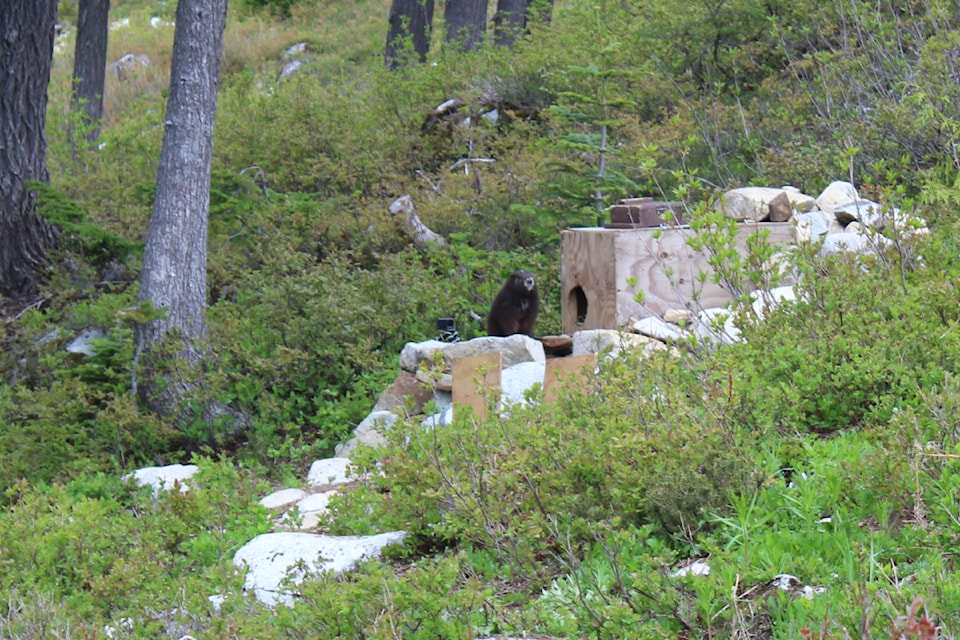A record-breaking number of wild-born Vancouver Island marmot pups have been recorded so far this year, and according to the Marmot Recovery Foundation, that number is expected to climb by year's end.
Adam Taylor, the foundation's executive director, said 89 marmots have been born in the wild this year, whereas in the past, the most pups ever counted in one year was 75.
"This [year] seems on track to be significantly higher," he said. "That 75 is the end-of-season consensus count [in 2011]. We are not at the end of our active season yet, and 89 is the minimum number of marmots, so we're not even comparing apples to apples and we're still well ahead."
Vancouver Island marmots have litters of one to five pups every other year, taking a break on the interm years to recover from the taxing birthing process. As a result, Taylor said he wouldn't be surprised by a birthing drop next year, but cautioned that may not be the case since 2023 had 60 pups born, causing the foundation to believe this year would experience a drop.
"We hope that there's lots of marmots that didn't give birth this year that are waiting to give birth next year, but if we had a decline in the number of pups next year I wouldn't be concerned after a really large number this year."
To track the numbers, the foundation reviews raw footage from GoPro cameras, strategically placed around the colonies.
Once born, the pups still have to compete with a series of threats. Taylor estimates that about 20 to 25 per cent of the pups will survive long enough to reach maturity.
"If everything continues to go well, this is going to be a real boon long-term to the population. If an average number of these pups survive to adulthood, and it's going to take another two to three years for them to reach adulthood, that will be a big boost."
The first threat the young pups will face is hibernation. Taylor said the marmots only have about six weeks left to build up enough body mass to survive in a hibernated state through seven months. Since they're herbivores, this process is heavily impacted by the season's vegetation.
"What we're seeing in the mountain meadows is that the vegetation is still very lush and green, it still looks like it's in good condition �㽶��Ƶֱ��� which is fantastic. We were really worried after that little snowfall that we had last winter that the meadows would dry up by the time snow arrived and that could pose a problem for all the marmots."
Another threat is predation from cougars and golden eagles. While predators are something the species has always had to contend with, the impacts of climate change introduced new factors into the equation. There is less snowfall on mountain tops, resulting in fewer avalanches clearing trees and creating the tree-less mountain meadows in which the marmots thrive. With more trees, predators have more places to hide.
"That heavy weight of snow, either creeping down slopes or coming down in the form of avalanches, it literally scrapes trees and taller vegetation off the slopes where marmots live which literally creates the marmot habitat."
To combat this, the foundation is planning tree removals later this year to prevent tree growth from creeping in, effectively giving the marmots a leg up.
On top of the environment and predation, there's still inbreeding. With the low number of marmots, it opens the door to the risk of a loss of genetic diversity. Taylor said when the foundation first began its work the Mt. Washington colony was heavily inbred, resulting in heart defects as well as compromised immune systems that resulted in hair loss.
In order to promote genetic diversity, the foundation selectively makes releases based on colony bloodlines during its captive-breeding program. Throughout the summer, the foundation released 60 captive-bred marmots, all one or two years old, into the wild population, which .
"The release groups are sort of formed to make sure there's a broad range of genetics available to maximize the potential for genetic diversity in the population."
To find out more, people can visit the Marmot Recovery Foundation's website at
Taylor said the foundation expects to complete its review of the footage and announce the complete wild-born pup count at the end of the year.
"It has been a lot of fun for me to be able to talk about this record number of pups, because the Marmot Recovery Foundation is an on-the-ground organization, I get that job and it's a delightful job to have this year," Taylor said. "But I always have to acknowledge that we could not do this work without the support of our partners."



